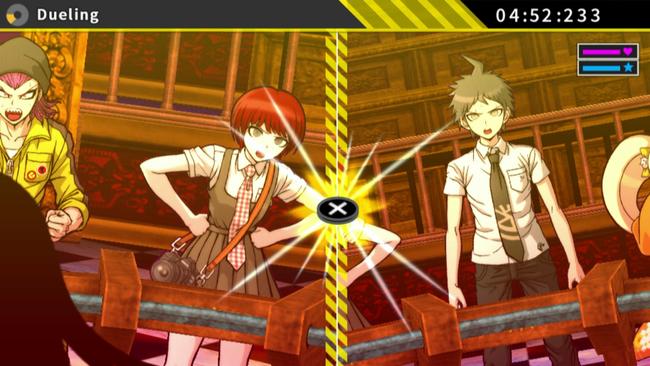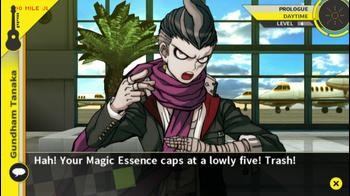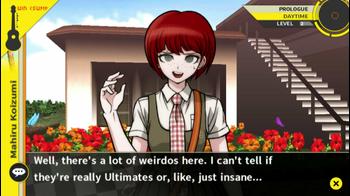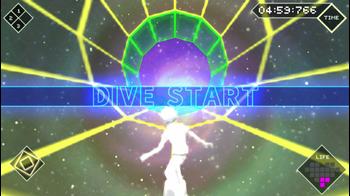
DanganRonpa 2: Goodbye Despair Review
Barely half a year has passed since the western launch of DanganRonpa: Trigger Happy Havoc. The intense genre-blending visual novel released to favorable reception, even achieving a rare perfect score from RPG Site. DanganRonpa 2: Goodbye Despair continues in the footsteps of its predecessor, bringing about another phenomenal experience unlike any other.
The premise is similar to the original, yet there is a distinct change in scenery. Getting away from the school setting, the new cast of gifted characters are trapped on a series of islands. With no knowledge of how they got there or why, these students are once again forced to play a game of death if they wish to escape and have their normal lives back. To do so, they must kill a fellow student and not get caught after an intense, heart-wrenching trial.
As with the first game, we’re introduced to a quirky cast of characters intentionally playing off anime tropes. Their ‘ultimate’ talents are seemingly there to define their personalities, but things aren’t quite as shallow as that. The dynamic between these caricatures remains amusing during moments of calm, which is turned on its head when more disturbing events creep into the plot.
Emotions run high during the latter, adding more intense layers to the deceptively dark interactions as the flawless ‘Ultimates’ show their true, insecure selves brought on by the horrifying situation they’ve found themselves in.
Everyone’s favorite psychopathic monochromatic bear makes a flashy return. This time, Monokuma is joined by a foil - the more benevolent rabbit known as Monomi. Monokuma’s joker-like act is still as darkly humorous as ever, with Monomi’s addition helping to prevent it from getting stale. Just whose side the rabbit is on is ambiguous, but those that played the first game will be well aware of Monokuma’s twisted personality and intentions. The sadistic bear continues pushing his despair-filled agenda, laughing manically at the cruel and disturbing deaths that he both instigates and directly commits. Love him or hate him, he remains an essential part of the DanganRonpa experience in keeping with the clashing tones.
Gameplay is once again split between exploration, free time, investigation, and class trials. With a much larger area to explore, there are new additions to the means of moving around. Alongside walking around in first person within the confines of specific areas, said areas can be accessed via a sort of overworld screen present on each island.
Right off the bat, the interface is made accessible, allowing quick travel via teleportation or sped-up walking. However, there is a reason to take it slow when traveling from place to place. Just by walking around, you can “level up”, something that helps in the trials as it widens the range of skills that can be selected. In addition there is a virtual pet mini-game that acts as a pedometer, tracking your steps which can net you nifty prizes like Monocoins (the in-game currency) and presents that can be given to other characters.
During free time, our protagonist Hajime can hang out with his fellow students. Just like with the first game, these are akin to social links in the Persona series. By bonding with the island inhabitants, you gain "Hope fragments", which can be used to buy skills for the trials. You will also learn more about said characters, bringing you closer to friendship as they open up about their pasts and dreams. While the cast is well-fleshed out during the main story, these interactions make them more sympathetic and are neat extras to further the already in-depth lore. Of course, anyone can die at any time. It's good to keep that in mind when choosing who to talk to, as Hajime obviously can't hang out with someone who's dead.
Once a murder takes place, an investigation begins. This plays out like a point-and-click adventure game, traveling between relevant locations and examining anything that could be a clue while also gaining some helpful testimonies.
After the investigation ends, the class trial begins. This is where the meat of the game lies. As with the original, these are presented like a more over-the-top Phoenix Wright, yet are mechanically distinct.
The class trials play out in largely the same way. Nonstop debates where you must “shoot” down arguments still takes up a good portion. One new function is the ability to not just contest remarks, but agree with them as well, expanding on someone’s deduction with your own. But that doesn’t mean people will ease up on their debating, as a new feature furthering their over-the-top disagreements has been introduced. This is known as the Rebuttal Showdown, another fast-paced argument against a single person where instead of ‘shooting down’ someone’s points, you ‘cut’ them down by either swiping the screen or pressing the face buttons.

Bullet Time Battle, the rhythm mini-game from the original, has returned as Panic Talk Action. While largely unaltered outside of a few aesthetic changes, the timed button presses and frantic arguments end in combining words to make a full phrase. This gives it its own identity as opposed to being an extension of the nonstop debates like it was in the original game.
An unexpected addition comes in the form of "Logic Dive", a snowboarding mini-game in a stylized cyberspace. Questions will pop up and the player must move to the correct answer, or risk falling off the platform. As with all the cross-genre mini-games, it's a very basic representation of said genre, yet its inclusion helps keep things fresh in the already hectic trials.
One of the most helpful additions comes from the Closing Argument. While still arranging panels in a manga-like set of pages, the missing panels as well as the blank spaces are labeled. As the small panels can be hard to make out, this makes a world of difference.
While there are many returning tracks, it’s hard to complain about the OST when the original game’s was phenomenal. Composer Masafumi Takada brings his A game again with some new tracks, evoking more discomforting and cheery feelings that fit perfectly with the clashing light-hearted and dark tones of the game.
Outside of the main game, there are a few nifty extras. Magical Girl Miracle Monomi is a sort of arena-based action game where summoning attacks via drawing circles to defeat enemies is the goal. School Mode also makes a return as Island Mode, a resource gathering alternate reality where no murders happen whatsoever. Without having to worry about people dying, it's easy to complete everyone's free time events. The resource-gathering is pretty addictive on its own as well.
Also included is DanganRonpa IF, a novel retelling the first game's story had the protagonist, Makoto Naegi found the escape switch right at the beginning. While not canon, it does further the lore even more and is relatively well-written for an extra.

Danganronpa 2 keeps things fresh both on the gameplay side and the story side. Many plot developments present in the first game are turned on their head or sidestepped in ways to keep things unpredictable, all culminating in an intense and emotional finale. Your favorite characters most likely WILL die, some via simple murders and some via cruel and humiliating executions.
The stylized and over-the-top presentation, yet meaningful interactions gives this a unique identity that oozes creativity well beyond typical "whodunnits" or even mystery works in general, while still remaining grounded enough to get attached to these characters, doomed or otherwise.
With a perfectly implemented contrast of tones, a likable cast of characters, subtle yet effective improvements on the already exciting gameplay, and a mind-blowing plot bringing everything to a satisfying conclusion, fans of the original won't want to skip this. Newcomers shouldn't either, but only after they have played the first one.



